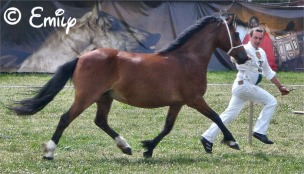The Cob Type - Active, surefooted and hardy

The Welsh Pony of Cob Type, Section C, is the stronger counterpart of the Welsh Pony, but with Cob blood.
Their true worth as a dual purpose animal has been fully realised in recent years, and their numbers have increased accordingly.
Active, surefooted and hardy, they are ideal for so many purposes both for adults and children.
Like all the Welsh Breeds they are natural jumpers and they also excel in harness — there are in fact few things that they cannot be used for.
The height should not exceed 13.2 h.h. (137.2 cms).
Source: WPCS - The Welsh Pony and Cob Society - www.wpcs.uk.com
General Character
Strong, hardy and active, with pony character and as much substance as possible.
Head
Full of quality and pony character. A coarse head and Roman nose are most objectionable.
Ears
Neat and well set.
Shoulders
Strong but well laid back.
Forelegs
Set square and not tied in at the elbows. Long, strong forearms. Knees well developed with an abundance of bone below them. Pasterns of proportionate slope and length. Feet well-shaped. Hoofs dense. When in the rough, a moderate quantity of silky feather is not objected to but coarse, wiry hair is a definite objection.
Action
Free, true and forcible. The knee should be bent and the whole foreleg should be extended straight from the shoulder and as far forward as possible in the trot. Hocks flexed under the body with straight and powerful leverage.
Colour
Any colour, except piebald and skewbald.
Eyes
Bold, prominent and set widely apart.
Neck
Lengthy and well carried. Moderately lean in the case of mares, but inclined to be cresty in the case of mature stallions.
Middlepiece
Back and loins, muscular, strong and well-coupled. Deep through the heart and well-ribbed up.
Hind Quarters
Lengthy and strong. Ragged or drooping quarters are objectionable. Tail well-set on.
Hind Legs
Second thighs, strong and muscular. Hocks, large, flat and clean, with points prominent, turning neither inward nor outwards. The hind legs must not be too bent and the hock not set behind a line falling from the point of the quarter to the fetlock joint. Pasterns of proportionate slope and length. Feet well-shaped. Hoofs dense.
